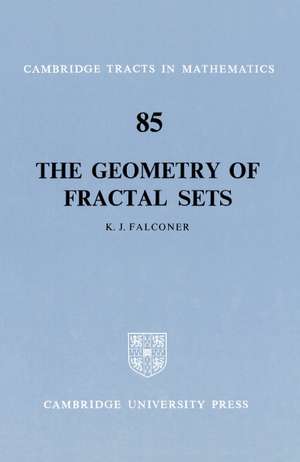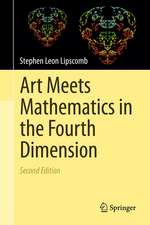The Geometry of Fractal Sets: Cambridge Tracts in Mathematics, cartea 85
Autor K. J. Falconeren Limba Engleză Paperback – 23 iul 1986
Din seria Cambridge Tracts in Mathematics
- 8%
 Preț: 452.92 lei
Preț: 452.92 lei - 9%
 Preț: 763.73 lei
Preț: 763.73 lei - 9%
 Preț: 808.05 lei
Preț: 808.05 lei - 8%
 Preț: 445.12 lei
Preț: 445.12 lei - 9%
 Preț: 661.69 lei
Preț: 661.69 lei -
 Preț: 187.36 lei
Preț: 187.36 lei -
 Preț: 187.58 lei
Preț: 187.58 lei -
 Preț: 187.20 lei
Preț: 187.20 lei -
 Preț: 187.58 lei
Preț: 187.58 lei -
 Preț: 187.20 lei
Preț: 187.20 lei -
 Preț: 186.98 lei
Preț: 186.98 lei -
 Preț: 186.82 lei
Preț: 186.82 lei -
 Preț: 187.36 lei
Preț: 187.36 lei -
 Preț: 306.72 lei
Preț: 306.72 lei - 14%
 Preț: 699.12 lei
Preț: 699.12 lei -
 Preț: 186.98 lei
Preț: 186.98 lei -
 Preț: 187.36 lei
Preț: 187.36 lei -
 Preț: 186.98 lei
Preț: 186.98 lei -
 Preț: 216.59 lei
Preț: 216.59 lei -
 Preț: 216.75 lei
Preț: 216.75 lei -
 Preț: 187.96 lei
Preț: 187.96 lei -
 Preț: 186.44 lei
Preț: 186.44 lei -
 Preț: 186.98 lei
Preț: 186.98 lei -
 Preț: 386.23 lei
Preț: 386.23 lei -
 Preț: 382.89 lei
Preț: 382.89 lei -
 Preț: 454.76 lei
Preț: 454.76 lei - 11%
 Preț: 576.82 lei
Preț: 576.82 lei - 11%
 Preț: 447.16 lei
Preț: 447.16 lei - 11%
 Preț: 414.66 lei
Preț: 414.66 lei -
 Preț: 449.20 lei
Preț: 449.20 lei -
 Preț: 451.88 lei
Preț: 451.88 lei -
 Preț: 423.91 lei
Preț: 423.91 lei -
 Preț: 449.20 lei
Preț: 449.20 lei -
 Preț: 435.31 lei
Preț: 435.31 lei - 11%
 Preț: 510.66 lei
Preț: 510.66 lei - 14%
 Preț: 784.53 lei
Preț: 784.53 lei -
 Preț: 306.47 lei
Preț: 306.47 lei - 14%
 Preț: 790.48 lei
Preț: 790.48 lei
Preț: 411.39 lei
Preț vechi: 462.24 lei
-11% Nou
Puncte Express: 617
Preț estimativ în valută:
78.72€ • 84.18$ • 65.63£
78.72€ • 84.18$ • 65.63£
Carte tipărită la comandă
Livrare economică 18 aprilie-02 mai
Preluare comenzi: 021 569.72.76
Specificații
ISBN-13: 9780521337052
ISBN-10: 0521337054
Pagini: 180
Dimensiuni: 154 x 228 x 11 mm
Greutate: 0.28 kg
Ediția:Revised
Editura: Cambridge University Press
Colecția Cambridge University Press
Seria Cambridge Tracts in Mathematics
Locul publicării:Cambridge, United Kingdom
ISBN-10: 0521337054
Pagini: 180
Dimensiuni: 154 x 228 x 11 mm
Greutate: 0.28 kg
Ediția:Revised
Editura: Cambridge University Press
Colecția Cambridge University Press
Seria Cambridge Tracts in Mathematics
Locul publicării:Cambridge, United Kingdom
Cuprins
Preface; Introduction; Notation; 1. Measure and dimension; 2. Basic density properties; 3. Structure of sets of integral dimension; 4. Structure of sets of non-integral dimension; 5. Comparable net measures; 6. Projection properties; 7. Besicovitch and Kakeya sets; 8. Miscellaneous examples of fractal sets; References; Index.
Recenzii
'This book is filled with the geometric jewels of fractional and integral Hausdorff dimension. It contains a much-needed unified notation and includes many recent results with simplified proofs. The theory is classically and rigorously presented with applications only alluded to in the introduction. Each chapter contains a short and important problem set. This is a lovely introduction to the mathematics of fractal sets for the pure mathematician.' American Mathematical Monthly












